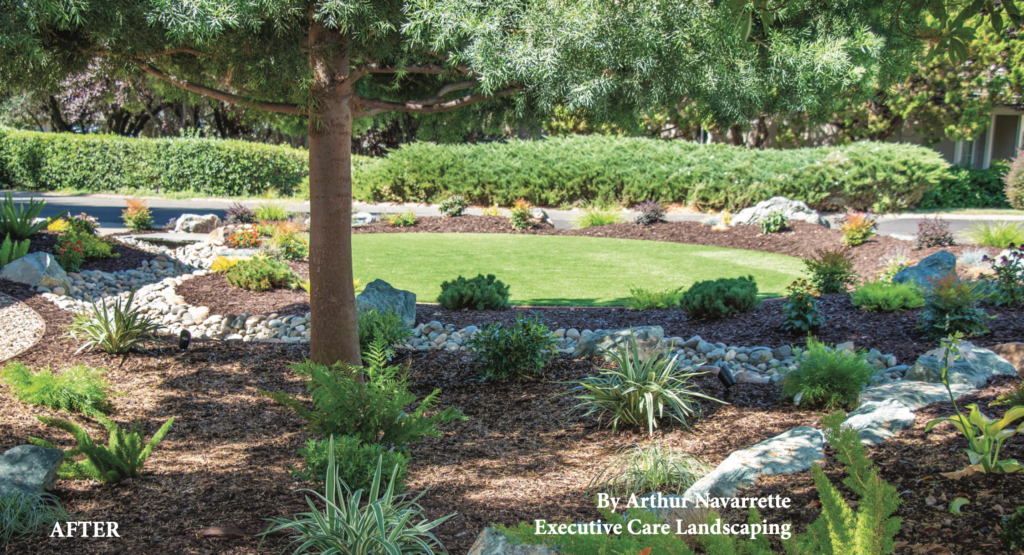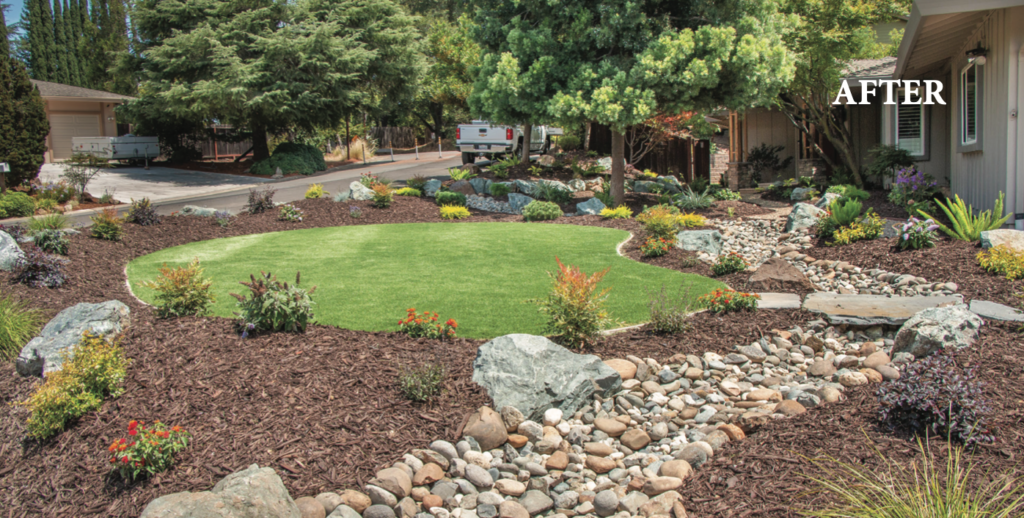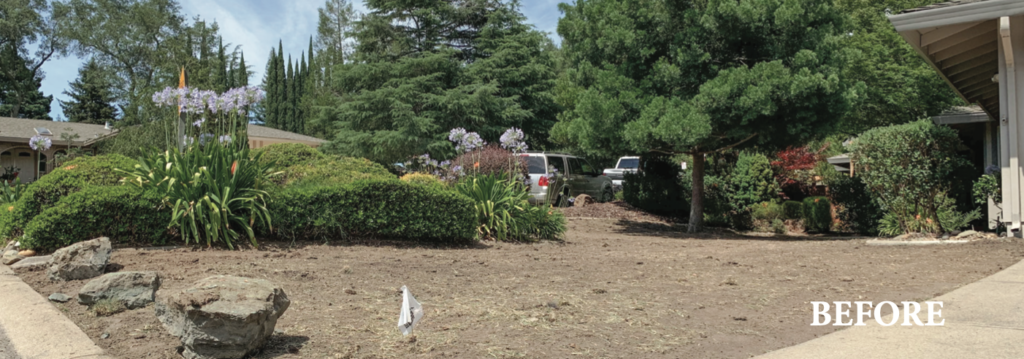Bienvenidos! Welcome to our September article, the second article in dealing with problems unique to corner homes. Roy and Tangie are repeat clients of ours and their home is in Fair Oaks. Roy and Tangie love their home and its location in general, however, being a corner home has some inherent challenges. Not only do they share the same concern as last month’s clients, but they see every car’s headlights as they turn down their street. They are also on the path of children going to and from school. Kids, being kids, will cut across the front yard rather than use the sidewalk.

Aside from these “corner lot” problems, the original landscape was old and in need of a face lift. The combination of these needs made it a good time to redo the front yard (our before picture shows the lawn already removed). Our client’s landscape before was largely the traditional landscape, being mostly lawn. There is a corner island (see before picture) that several years ago had an Olive tree, which has since died. The other trees in the front yard, especially the one in the lawn had matured and now was shading out the lawn. Not only is too much shade detrimental to the lawn, but the roots of the tree competing for water stress- es it out. Although Roy liked lawn, the tree provided shade so he conceded that less lawn might be the wiser decision, and both Roy and Tangie were okay with using synthetic turf. The goal was to reduce the maintenance by keeping the mowing just to the back. Tangie was excited because with less space being allo- cated to the “lawn”, she would get to enjoy more plants and flow- ers along with the butterflies and hummingbirds they attract. Their son is young, and this would be a good way to support his interest in nature.
Processing their concerns and wants, as well as considering the sun patterns throughout the day, the design that worked best for them was to have a shade landscape by the front door, and a sun landscape out front. We would design the mounds, boulders and plants around the synthetic turf and for added protection, we would put our largest boulders at the corner, just in case. The transition point between sun and shade was a twelve-foot area between the tree and the dry stream bed that had similar hours of sun and shade. So, the challenge of this yard, aside from the other design concerns, was the plant selections. There was going to be plants from each light zone, and at the meeting point I would need to use plants that pre- ferred shade but could also take late afternoon sun (not easy). Also, in this same area I needed plants that preferred sun but could take extended hours of shade. The goal was to interweave these plants among the other plants of their preferred light zone. I wanted there to be a natural “soft” transition between the two extremes. A similar scenario to this is the tidal zone we have along our rocky shores.
Now that you understand the challenges from a landscaper’s eye, let’s discuss the solutions. Many men seem to like lawn, so deciding to go with artificial turf can be a quantum leap, both in thought and at times cost. The thought was tough for Gary (last month’s client) because he was more of a naturalist. Roy, however, was more concerned about the look, he didn’t want it to look fake. Both men were okay with the cost, which was nice. Good quality artificial turf can be pricey, and the cost has as much to do with its design. If the artificial turf can be put down as it comes, or if it needs to be patched, the cost will be affected. Synthetic turf, as explained last month comes in fifteen-foot widths. The width here at the widest point was 22 feet, and the length was twenty-five. A somewhat kidney shape is what best fit the yard, which meant we had to order extra synthetic turf and patch it to get our total width. One downside to synthetic turf is waste because of its limited size availability. Unfortunately, we get unusable pieces. We obviously want to minimize this, however anything other than a rectangular shape no wider than fifteen feet will have waste, it’s unavoidable. For blocking the headlights of incoming vehicles, we created higher than normal mounds around the synthetic turf. We coupled this with larger boulders, and fortunately the home sat low making bushes that matured three to four feet sufficient to accomplish the goal of blocking the headlights.
The kids can still try to cut through this landscape, however there is no longer a clear path to follow. It is my theory that be- tween the added mounds, boulders, plants and a dry stream bed that it is not worth the effort. We’ll see if my theory proves true. The stream bed was optional, but as we saw the design forming, we all agreed that the extra “busy” it gave to the landscape was nice. It became the divide between full sun and partial sun. Dry stream beds are not for every client, and there is a point where too many features become too much, however this depends on the client’s preference and what plants are selected. Fortunate- ly, shade plants with their different shades of green and wider leaves are calming, and these were planted close to the house and the really colorful and creative part, which for some could be interpreted as busy, was out front. It turned out to be a nice combination of plants and design that I was really happy with.
More importantly, Roy and Tangie were pleased. They let me know that many neighbors came by to compliment them on their yard. If I may toot our horn (the men and I), we get those compliments on every job, which is a great feeling. Next month I will be featuring both homes, August and September issues. I will be doing an article on the importance of night lighting- both from a safety concern as well as from an aesthetic point of view. Lastly, gardeners it is time to remove our summer vegeta- bles and prep the soil by tilling in a heavy dose of organic fertilizer. Water it well, and let it sit for a couple weeks before starting with fall and winter crops. Until next time — Good Gardening.


